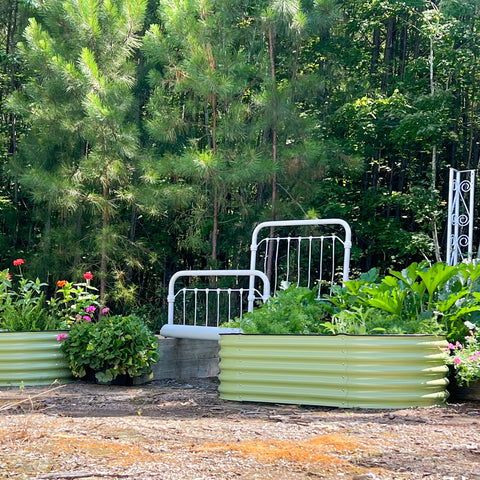Mexican Hat Flower: What To Plant In Raised Garden Bed
The Mexican hat flower gets its name from the gigantic cone in the middle of the flower, which is said to resemble a sombrero or hat. It comes in a wide range of colors from dark red, reddish brown, and red and yellow. The Mexican hat plant has a very active growing season and blooms from late spring into early fall. Olle is going to show you about this plant.
Like many echinacea, the prairie echinacea, also known as Mexican cowslip, is a great pollinator plant. It is also relatively drought resistant and thrives in the hot, dry climate of the western United States.
The most common cone flower is probably Echinacea purpurea, which is famous for its application in herbal tea. Mexican hat plant can also be used for tea, and is also used as a treatment for poison ivy. Consider adding this cone flower to your pollinator's garden, and you will also get an edible source of herbal tea!

Mexican cap plants are also known for their resistance to deer and relative pest and disease. It is called Latibida columnar plant, and it is a fast growing plant. One disadvantage is that it may crowd out weaker plants nearby. Give these wild flowers enough space in a sunny place in the garden, and you won't be disappointed! They also attract many useful pollinators to your garden, such as wild bees, butterflies and hummingbirds.
About Mexican hat flower
Ratibida is also called prairie cone flower, red spike Mexican hat flower, thimble flower or erect prairie cone flower. Mexican cap plants are native to the Great Plains of North America, from southern Canada to northern Mexico and most of the United States. This perennial belongs to the Asteraceae. People grow Mexican hats for beautiful cut flowers.
The flower head is similar to other members of the family Echinacea (such as Echinacea purpurea), but has an obvious erect seed head, which forms from the center of the pendulous petals. This long headed cone flower is supported by a slender stem and has bright green, feathery and deeply split leaves. This colorful cone flower can range from red and yellow to reddish brown.

In order to obtain the best germination effect, Mexican hat seeds need a period of cold stratification. Use high sowing rate to sow in autumn, broadcast small seeds, and then gently rake the area for sowing. In early spring, water regularly until the Mexican cap plant is established. Their flowering time will vary according to your region, but the range is from late spring to summer, to late summer, and even to early autumn.
Mexican hat plant care
As we all know, Mexican hat plant care is low maintenance, making it an excellent choice for garden areas you want to fill without adding another plant care schedule to your agenda.
Sun and temperature
The reddish brown Mexican hat plant thrives in full sunlight. However, they will tolerate light shadows. They are the perfect choice for you in the sunny border of the cottage garden. With 6-8 hours of sunshine every day, this truly colorful cone flower variety will bloom in large numbers. The ideal habitat for this plant is the 4-8 habitat of the United States Department of Agriculture.
Because seeds need to be layered for a period of time, cold areas in winter allow them to reproduce naturally. In areas with warm winter weather, the cold period can be simulated by placing the seeds in the refrigerator for several weeks before planting.

The ideal temperature range for this plant is between 65-75 degrees Fahrenheit. When the temperature in midsummer starts to keep higher than 90 degrees, flowers tend to die and enter the seed state. These plants will die completely at the first sign of mild frost.
If you want to enjoy these flowers all year round, you can consider planting them in indoor potted plants. They can grow in any warm, well lit indoor environment. However, they are growing rapidly and may need to be repaved from time to time. Although these plants are particularly drought tolerant, they may need some additional water during prolonged periods of high temperature and drought. Covers can be used to help conserve water, especially in poor soils, and reduce the need for watering.
It is best to water these plants early in the day or in the evening after a hot day. Watering at the hottest time of the day can ensure that part of the water evaporates before reaching the root. These plants need to be watered regularly during spring germination and initial growth.
However, once they are established, they need less water. Although these plants are particularly drought tolerant, they may need some additional water for an extended period of time. Covers can be used to help conserve water, especially in poor soils, and reduce the need for watering.
It is best to use soaking hose or drip irrigation pipe to water the bottom of plants. Drip lines are particularly useful for large-scale planting, as it may be more difficult to reach the bottom of each plant using hoses. Once the plant is sown, you can stop watering completely. Let the seed head dry on the plant, and then carefully collect next year's flower seeds!
Soil
It is well known that Mexican cap plants live in various soil types. These native plants usually exist in grasslands, grasslands, roadside and other areas where soil is disturbed. However, they need well drained soil because excessive water can cause problems for this plant. The best growth medium for columnar alfalfa should be a mixture of well drained, slightly sandy loam. Mexican cap plants have no specific soil pH requirements and can survive in neutral to alkaline soil.

Fertilize Mexican hat plants
One of the benefits of growing native plants like Mexican hat plants is that they don't need fertilizer at all! The hat plant care in Mexico not only has low maintenance cost and needs low water consumption, but also prefers sandy soil, and they do not need any fertilizer. Fertilizing Mexican cap plants will not harm them at all; It's just not necessary. Planting in a sunny place, with well drained soil, you will enjoy Latibida columnar plants all summer long.
Growing problems
The seeds of the genus Ratibida are very small, which makes it difficult for them to sow, because they can be blown away or disturbed, and eventually reach outside the area where you want them to grow. They really need light to germinate, so they cannot sow deeply to avoid this problem. They can broadcast in exposed soil areas and are covered with a layer of fine vermiculite, which will help to hold them in place, but still allow light to pass through.
pest
If you notice that there are holes in the leaves of your grassland echinacea, and the leaves seem to be skeletonized, you may have a problem with Japanese beetles. They are copper black, with a metal turquoise head, easy to find and identify. If the intrusion is very small, it can be manually picked from the plants and put into a bucket of soapy water.
In case of large disturbance, neem oil can be sprayed on plants to control adults. However, the Japanese beetle winters underground as a maggot, so in more serious cases, you can treat the ground with milky white spore powder every year. The milky spores are eaten by maggots, which then kill them and prevent the next generation from growing into adults. The best time for this treatment is in autumn. Please note that milky spore powder may take a while to be effective, so this is an ongoing annual treatment plan.
Aphids are sometimes seduced by grassland conifers. The best way to fight aphids is to spray them out of plants once they are found. To prevent them from returning and/or overtaking your plant, creating an environment that includes a variety of flowering plants will attract pollinators and other beneficial insects that like to chew aphids, such as ladybirds. In more severe infections, neem oil or insecticide soap can also do this.

disease
Most of them are disease-free. However, if the planting site has poor drainage soil or suffers from excessive watering, the root rot problem may occur. They do not like standing in water, so providing them with well drained soil will help avoid this problem.
Planting them in the right soil also helps. However, if you notice the withering, even if it has received a lot of water, the paste of the stem, and the lack of new growth, it may indicate decay. Let your plants dry completely before watering again to help starve the fungus. The application of copper fungicide has different evaluation in the treatment of root rot.
common problem
Q: Are Mexican hat flowers perennial?
A: Yes, they are perennial and release seeds for the coming season every year.
Q: What is a Mexican hat A: A fast growing wild flower in Asteraceae.
Q: How do you take care of the Mexican hat factory?
A: Put this pillar flower in a sunny place in the garden. Once established, it is very low maintenance, drought resistant, deer resistant and disease free.
Q: Where is Mexican hat flower originated?
A: The original range of the Mexican hat is on the Great Plains of North America, from southern Canada to northern Mexico, including most of the United States.
Q: How long do Mexican hats bloom?
A: The flowering time depends on several factors. Watering in summer can prolong the flowering time and remove dead corners or flowers to encourage more flowers. Generally speaking, they will bloom from spring to late summer.
Q: How tall is the Mexican hat?
A: It can grow between 2 feet and 4 feet high
Q: How often do you water Mexican hat plants?
A: Once established, this easy plant has a high level of drought tolerance and thrives in arid areas. Having said that, they will need to replenish water under long-term drought or extreme high temperature. During the drought, water about 1 inch a week, but be careful not to over water, because too much water can also cause problems.
Q: Are Mexican hat plants succulent?
A: Mexican Hattleflower is a tall grass cone, not a succulent plant. However, there is another plant called the Mexican hat plant. The Kalanchode birch is usually called the Mexican hat plant, the devil's spine or alligator plant, which is actually a succulent plant, and has nothing to do with the Latibida columnar plant.
